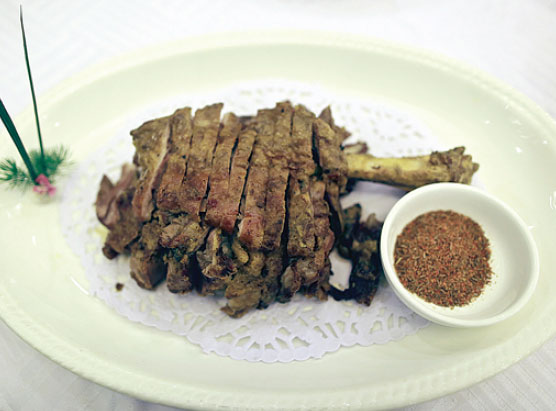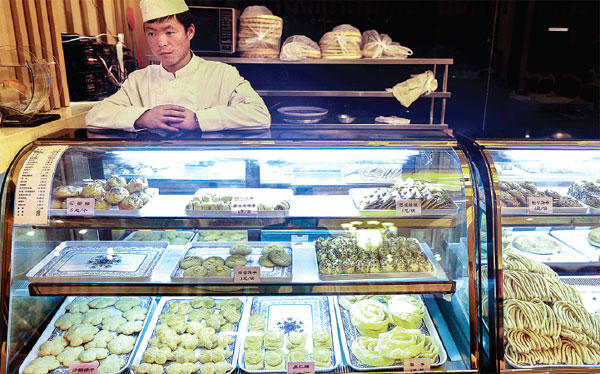Taste of Kashgar
Updated: 2015-01-22 07:13
By Yang Feiyue(China Daily)
|
|||||||||||
Evoking the wild-west aura of the caravan days, a Beijing eatery captures the rustic charm of a vibrant cuisine, Yang Feiyue reports.
Being tucked away in a quiet hutong hasn't stopped Kashgar Restaurant from becoming one of the most popular Xinjiang eateries in the Chinese capital.
The unassuming decoration makes the restaurant more like a traditional Chinese canteen. The noisy atmosphere created by customers doesn't make for a very cozy and intimate dining experience, but is a testament to the restaurant's popularity.
|
A staff member (above) sells traditional Xinjiang snacks at Kashgar Restaurant, a highly popular Beijing eatery that offers a variety of Xinjiang food including the famous roasted lamb leg (below). Photos by Feng Yongbin / China Daily |

Kashgar offers a variety of traditional Xinjiang food, including roast mutton, hand-pulled noodles and authentic snacks. Chen Yuxin, a 28-year-old chef with the restaurant, says that Kashgar cuisine is the most authentic in the Xinjiang region because it's so far west, and thus less affected by influences from other parts of China.
The roasted lamb leg (168 yuan or $27) is an eye-opener, because it retains the shape of the leg on the serving plate. The chewy mutton is sliced into bite-size chunks, which are loosely re-assembled and presented atop a leg bone. The skin is roasted into a thin, crisp layer and blends in with the thick and tender meat.
Any unpleasant mutton scent is eliminated through the preparation, cooking and seasoning, and the lean and fat meat layers blend lushly together on the palate. But do eat it up while it's hot, because the meat hardens and loses its easy-to-chew tenderness once cold.
The chicken with hot peppers (45 yuan for half a portion) was the sassiest dish we ordered - potentially a challenge for those who have little tolerance for spicy food. This cold dish is already an adaption of the original version, which is much more pungent and spicy, the chef tells us later. In this version, the heat slowly spreads in the mouth and paralyzes the tongue. The chicken pieces include skin and bone, and the meat has a very springy texture.
The Xinjiang yogurt (7 yuan per bowl) is a treat. It's delightfully sour and sprinkled with white sesame and raisins. The plump fruits are elastic and lusciously sticky, as if they've been pre-soaked in a sweet syrup or honey, and the flavor plays nicely against the yogurt's natural tartness. It's good to slurp a few spoons of it after eating strong dishes like the chicken with hot pepper, clearing the palate so you can enjoy the full flavors of other foods.
The baked bun stuffed with mutton (4 yuan per bun), a traditional item for breakfast, wears a very thin flour skin stuffed with onion and mutton dressed in cumin and black pepper. It leaves a fresh mutton aroma in the nose when you exhale. Unlike many Chinese stuffed buns, whose stuffing is usually mashed into paste, making it impossible to tell ingredients, the Xinjiang buns feature clearly cut and recognizable mutton pieces.
The bean jelly (12 yuan) is a surprise. Made of mung-bean starch, the jelly noodles practically melt in the mouth without chewing. The cold dish carries a hint of spiciness that slowly develops but then quickly fades away.
The Xinjiang-style cold noodle dish (10 yuan) is indiscriminate: We found those angel-hair-like noodles to be knotty and hard to chew, as if exposed to the air too long.
The stir-fried noodle with vegetables (18 yuan) is slightly greasy, and a sauce of tomato and spices give it a sweet and tangy taste. Like most portions here, the serving is generous. The noodle is boiled very soft and saturated with the cooking sauce.

While restaurants from many Islamic cultures shun all forms of alcohol, the Uygurs - like their neighbors in the Tibet autonomous region - consume both locally made wines and beers. Barley is the favored grain for beer-making in China's far west, and the Kashgar restaurant in Beijing offers the Sinkiang brand in both yellow and black brews (13 yuan per bottle). Many of the sweets you can buy from the friendly vendors in the stalls on nearby Niujie (Ox Street) are also sold here.
The servers are all polite and prompt, and Wi-Fi is available at the restaurant, which is run by the provincial government's office in the capital.
If you go with more than 10 people, you can get bumped up to the second floor's large tables and private dining rooms. Some of the dishes are in limited supply, such as the roasted lamb leg (28 sets available a day) and the braised camel palm (10 sets a day). So, call to preorder such items before you go.
Contact the writer at yangfeiyue@chinadaily.com.cn
(China Daily 01/22/2015 page24)
Today's Top News
China aims for stronger links with fragile Europe
China to instill national characteristics in think tanks
Shanghai govt releases report on stampede tragedy
Fake condoms, Viagra, seized and online network shut down
Economic growth edges to 24-year low of 7.4%
Visitors from overseas to get refunds
UN condemns escalating attacks by Boko Haram
Foreign leaders making splash on front page of Party's paper
Hot Topics
Lunar probe , China growth forecasts, Emission rules get tougher, China seen through 'colored lens', International board,
Editor's Picks

|

|

|

|

|

|






